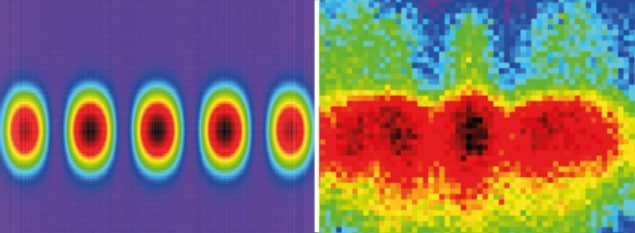
Physicists using the SOLEIL synchrotron in France are the closest yet to realizing a thought experiment first proposed in 1927 by Albert Einstein. A variation on the much-loved double-slit experiment, the measurement confirms an aspect of quantum theory that Einstein had sought to discredit. The SOLEIL experiment uses two excited atoms in place of the two slits of Einstein’s experiment and shows that when one can determine which atom has emitted an electron, a quantum interference pattern vanishes.
Einstein made several attempts to refute the inherent uncertainty of quantum mechanics by proposing thought experiments, which could not be performed in the lab at the time. One involved the principle of wave–particle duality, which predicts that a succession of single particles passing through two slits will build up a wave-like diffraction pattern on a screen. This occurs because the wave-like property of each particle allows it to travel through both slits at once. Einstein pointed out that an extremely sensitive sensor could detect the recoil of the individual slit that each electron passed through, while not disturbing the diffraction pattern. This flew in the face of quantum mechanics, and Einstein’s great rival, Niels Bohr, countered by arguing that the diffraction pattern would simply not occur if the experimenter knew which slit each electron had passed through.
While this was a pure thought experiment at the time, its combination of conceptual simplicity and formidable experimental difficulty has provided an irresistible challenge for modern-day experimentalists. In 2001 Serge Haroche and colleagues at the Ecole Normale Supéérieure in Paris demonstrated the principle in an analogue system, using a microwave pulse to split the internal state of a small number of Rydberg atoms into two separate states that evolved at different rates before being recombined. Then in 2011 Jörg Schmiedmayer and colleagues at the Vienna University of Technology achieved a closer approximation.
Double-atom experiment
Now, Catalin Miron and colleagues at SOLEIL, together with collaborators in Sweden, Japan and Romania, are the closest yet to recreating the original thought experiment in the lab. They use a diatomic oxygen molecule that is excited by tunable X-ray synchrotron radiation on the PLÉIADES beamline. By adjusting the X-ray energy, the researchers can promote an electron from an inner molecular orbital into either a high-energy bound state or a repulsive state in which the molecule breaks apart. After this transition, one of the atoms emits another electron called an Auger electron, recoiling as it does so.
If the first electron has been promoted to the bound state, it relaxes back to the molecular ground state and the two atoms recoil together when the Auger electron is emitted. This means that measuring the recoil of the atoms reveals nothing about which atom emitted the electron. However, if the electron has been promoted to the repulsive state, the molecule breaks apart to create separate oxygen atoms. If the Auger electron is emitted after the molecule breaks apart, the atoms will not recoil together, and measuring the recoil of the atoms will reveal which atom ejected the electron. The two atoms therefore act as the slits of the thought experiment, and the emission of an electron is analogous to a particle emerging from the two slits. If the atoms recoil together, we do not know through which slit the electron passed – but if only one recoils, we do know which slit was used.
In place of the screen, the team used an extremely elaborate, self-built and unique machine called EPICEA, which measures all three components of the momenta of both the emitted electron and the recoiling atom left behind. “This is actually what I built for my PhD thesis 20 years ago,” says Miron.
Einstein wrong again
By correlating the emitted electron energy to the angle between the electron emission and the axis of the diatomic molecule for a large number of photon–molecule collisions, the researchers electronically reconstructed the “interference pattern”. By looking at the Doppler shift of the recoiling ion, the researchers could also calculate whether one or both atoms had recoiled. When the two atoms were indistinguishable, interference fringes were produced (see figure); whereas when the emission bore a clear signature of having come from one atom or the other, a continuous band was produced with no evidence of fringes. This is in good agreement with high-level theoretical calculations – and shows once again that Bohr’s interpretation of the thought experiment is the correct one.
Jörg Schmiedmayer calls the work “a nice demonstration of a very fundamental effect”, and explains that while, in principle, “the physics is exactly the same in Haroche’s experiment or in our experiment…in these other papers up till now the slit was a photon or something like that. Here you have two matter particles that are your two slits. These are steps that are getting closer and closer to the original proposal of Einstein and Bohr.”
The research is described in Nature Photonics.
- In 2002 Physics World readers voted the double-slit experiment with electrons “The most beautiful experiment”



